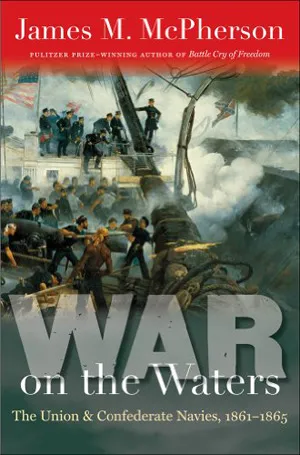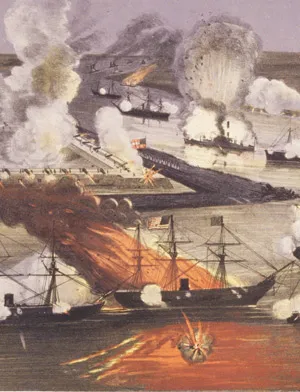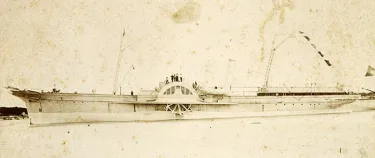Book: War on the Waters

The Trust spoke with Dr. James McPherson about his book, War on the Waters: The Union and Confederate Navies, 1861-1865, which looks at the significant contributions that both the Federal and Confederate navies made to the American Civil War.

Trust: What attracted you to writing about the Union and Confederate navies during the Civil War?
James McPherson: I have long felt that the role of the navies in the war, and especially the contribution of the Union navy to final Northern victory, has been under-appreciated and under-studied. My book is a modest effort to address that problem. Also, the feats of the navies make for a dramatic story, and I wanted to tell part of that story.
Sailors and naval officers were only 5% of the total number of Federal men under arms. In your opinion was their impact proportional to that small size?
JM: Their impact was much greater than the 5 percent of navy personnel--and also greater than the 12 percent of the navy's proportion of the financial cost of the Union war effort. Some of the most important strategic Northern victories in the war were either exclusively naval victories or successes of combined arms in which the navy's contribution was essential: Port Royal, New Orleans, Forts Henry and Donelson, Memphis, Vicksburg, Mobile Bay, Fort Fisher. Neither McClellan's Peninsula campaign in 1862 nor Grant's investment of Petersburg and Richmond in 1864-1865 would have been possible without the Union navy's control of the Chesapeake Bay and James River, by which McClellan's and Grant's armies were supplied. The blockade, leaky as it was especially early in the war, was nevertheless an essential part of Union strategy that made a crucial contribution to Union triumph in the end, as did the navy's control of the Mississippi, Tennessee, and Cumberland Rivers, which penetrated like arrows into the heartland of the Confederacy and made possible the successful army campaigns by Grant, Rosecrans, and Sherman.
How would you rate US Secretary of the Navy Gideon Welles’ contributions during the Civil War?
JM: Welles was an energetic and successful administrator who played a key role in building up the Union navy and devising its strategy. I think he make a major contribution to ultimate Northern victory, despite the criticism he had to endure from merchants, newspapers, and others over the success of Confederate commerce raiders against American shipping and also over the failure of the navy to stop more of the blockade running.
Despite their many disadvantages the Confederates crafted an interesting naval strategy. How would you summarize their plan?
JM: The Confederates did the best they could with limited resources, and I think their focus on ironclads, commerce raiders, and "torpedoes" stretched those resources as far as they could go even though, in the end, they could not come close to matching the power of the Union navy or preventing its successes. Their plan was to emphasize technological innovation (ironclads and torpedoes) to counter the strength of the enemy, and attack vulnerable American mercantile commerce to weaken Northern support for the war and divert Union naval strength from the blockade to pursue the raiders. In the end these efforts enjoyed some success (the raiders destroyed or captured more than 250 American merchant vessels and torpedoes sank or damaged more than forty Union naval ships), but they were nevertheless not sufficient to cut seriously into Union naval supremacy that helped win the war. The Confederates also developed a primitive "submarine" (the H.L. Hunley) which sank a Union blockade ship off Charleston in February 1864, and developed steam-powered "torpedo boats" that damaged a couple of Union warships, but these achievements did almost nothing to weaken the blockade or Union naval power.
In your book you highlight some of the Union victories in 1861 and 1862 that were derived largely or wholly from US naval actions. What were some of the most important ones?

JM: Hatteras Inlet, Port Royal and the capture or closure of several Confederate ports along the South Atlantic coast, the Monitor's neutralization of the CSS Virginia, the capture of Roanoke Island, New Bern and Beaufort, NC, and other North Carolina ports on Albemarle and Pamlico Sounds, Forts Henry and Donelson and the consequent control of the Tennessee and Cumberland Rivers deep into the Confederate heartland, Memphis, and control of nearly all of the Mississippi River except the portion between Vicksburg and Port Hudson.
Would you describe any meaningful differences in the strategy and management of the so-called “blue-water” and “brown-water” navies?
JM: The blue-water navy's principal task was to establish and maintain the blockade, and to do so the navy captured several ports and estuaries to establish bases for the blockade fleet. In the case of David Glasgow Farragut's blue-water squadron, after its capture of New Orleans it also became--reluctantly--part of the brown-water fleet on the Mississippi in 1862 and 1863. The blue-water ships were entirely manned by naval personnel, while the brown-water Western Flotilla was originally built and administered by the War Department and many of the crewmen on these river gunboats and ironclads were army personnel, though most of the officers and much of the ordnance were provided by the navy. After October 1862 the Navy Department administered the brown-water navy, and its name was changed to the Mississippi Squadron. Its mission both before and after October 1862 was to control the navigable rivers and provide support for army operations using the rivers as their supply line and river ports like Nashville and Memphis as their bases.
Although many blockade runners were able to enter Confederate ports, you point out that the Union blockade was still successful. How so?

JM: The blockade was successful because, while most of the blockade runners got through, the important fact is the wholesale reduction of the Confederacy's foreign and intra-coastal commerce because most merchant ships did not try to breach the blockade. The South's exports and imports during four years of the war were less than one-third of those during the four last antebellum years. Imports of much-needed iron for rails, ships, ordnance, and other war materiel were almost completely cut off by the blockade. The ten million bales of cotton exported during the last four antebellum years were cut to one million bales or less during the four years of war. Runaway inflation and the disastrous deterioration of the Southern rail network that caused the Southern war economy to break down completely by 1864-65 were, in considerable part, a result of the blockade.
International law seemed to be a serious thorn in the side of the Federal efforts to stop maritime commerce headed for the Confederacy. What efforts did the US Supreme Court make in setting important naval precedents?
JM: The Supreme Court's 5-4 decision in the Prize Cases (1863) upheld the constitutionality of the blockade, which had earlier been recognized as legitimate by the major maritime powers abroad.
Many know about the dawn of the ironclad warship, but where there other great technological naval innovations brought forth by the Civil War?
JM: The rotating gun turret (first used on the Monitor) and Confederate developments in naval mines (torpedoes) were major innovations. And of course the H. L. Hunley was a spectacular innovation that cast a long shadow toward the future of naval warfare. Most of the other naval innovations--steam power, the screw propeller, shell guns, rifled guns, even ironclads--antedated the war, though all of these innovations were much improved and expanded during the war.
Did Confederate commerce raiders like the CSS Alabama, CSS Florida, and CSS Shenandoah have any meaningful impact on the war?
JM: In the end the achievements of these commerce raiders, while spectacular, had only a marginal impact on the Northern war effort--they did divert some ships from the blockade, and they did drive the merchant marine into foreign registry, but these accomplishments did little or nothing significantly to hinder the Northern war effort--though they did have a major impact on the future of the merchant marine, which never fully recovered.

Why was Farragut’s success at Mobile Bay so important strategically?
JM: It closed an important blockade-running port, and gave a shot in the arm to Northern morale at a low point of that morale.
What sort of lasting legacy did the naval actions of the Civil War have on future wars?
The wartime innovations and improvements in steam power, ironclads, gun turrets, "torpedoes," submarines, the advances in riverine warfare, and fleet actions against shore fortifications, were studied and sometimes applied in future naval conflicts.
Any hints on what the subject of your next book will be?
JM: My next book will be a study of Jefferson Davis as commander in chief.
Buy the Book: "War on the Waters" is available in our Civil War Trust-Amazon Bookstore
James McPherson was born in North Dakota and raised in Minnesota, where he graduated from Gustavus Adolphus College in 1958. He received his Ph.D. from Johns Hopkins University in 1963. From 1962 to his retirement in 2004 he taught at Princeton University, where he is currently the George Henry Davis '86 Professor of American History Emeritus. Several of his books on the era of the American Civil War have won prizes, including the Pulitzer Prize (1989) for Battle Cry of Freedom: The Civil War Era and two Lincoln Prizes (1998 and 2009) for For Cause and Comrades: Why Men Fought in the Civil War and Tried by War: Abraham Lincoln as Commander in Chief. He has been associated with battlefield preservation since he first joined the board of the Association for the Preservation of Civil War Sites back in 1990. He has served as president of the Society of American Historians and of the American Historical Association. He is currently working on a book about Jefferson Davis as Commander in Chief.
Related Battles
2,691
13,846
369
24
322
1,500





